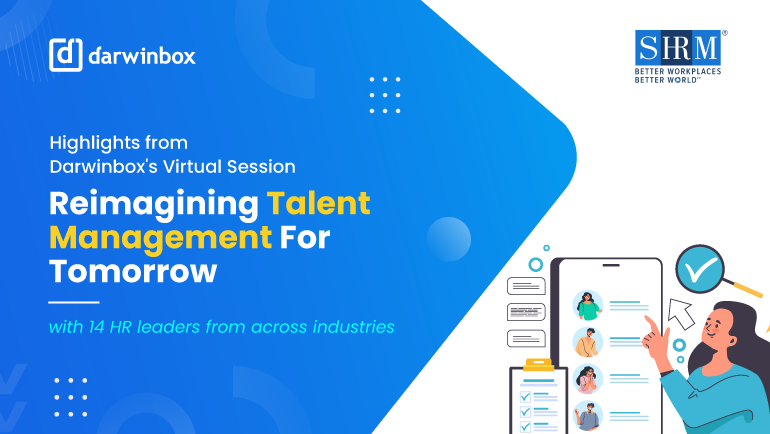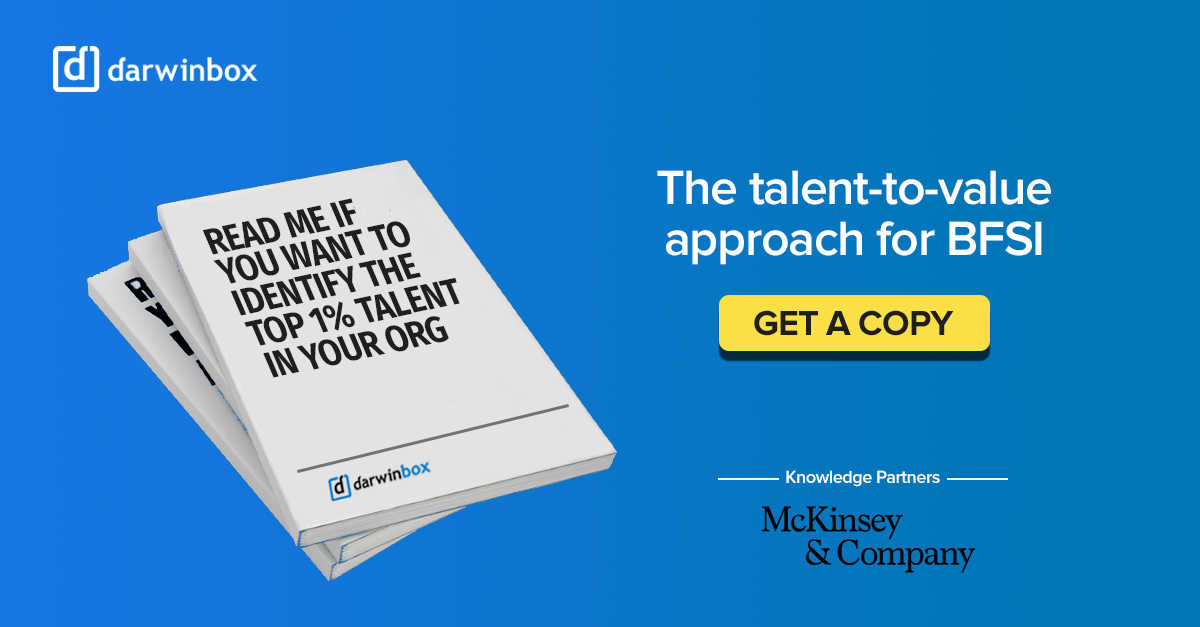
Like every other aspect of business, Talent Management was forced through a tumultuous period of adaptation and evolution in the wake of the lockdowns of 2020. Even a year after the world ground to a halt, organisations are still learning.

Agility has emerged as one of the key themes that businesses are focusing on now. Companies want to be nimble and be able to move freely no matter what the next big change is. Businesses have accepted that technology is here to stay, for better or for worse, simultaneously a disruptor and an enabler.
So how is Talent Management being reimagined in this scenario? What are the hurdles it has faced, and how is it evolving to overcome those hurdles?
Darwinbox spoke to a host of Talent Management experts on this topic in our webinar hosted in partnership with SHRM, “Reimagining Talent Management For Tomorrow”. Here are the most pertinent themes that emerged from the discus
The biggest disruptors of Talent Management today
Uncertainty
Recent global events have shown us that the business environment is far more uncertain than any of us would have expected. Whether it’s because of technology, a force majeure, or something else, there’s no way of knowing what the situation will be even a few years from now. We don’t know which functions will be required and which will be replaced. This has made workforce planning a tricky affair.
Rebuilding employee confidence
No one could predict what would happen after the first lockdown hit. In many cases management panicked, sending ripples across the organisation. Now that we have perhaps seen the worst, and the world is adapting to the new normal, many businesses are facing the issue of re-instilling confidence into their workforce.
Job parity is skewed
Work-from-home mandates and other factors have made certain roles niche, and now high in demand. In the IT sector, for example, folks who lost their job one year ago used the interim time to upskill themselves and are now able to demand huge hikes on their last salary, even more than 100% in some cases.
Attract, retain, and engage
For Talent Management, it ultimately comes down to this trinity. How is the organisation getting and keeping talent? As for engagement, what we mean is that the “employee is completely satisfied and contributing towards the goals of the organisation”. While many reports have claimed that engagement since the lockdown period has gone up, this is largely because many employees are working from home. In this situation, a lot of the internal connect and cross-functional learning that happens on the floor has gone for a toss. So this is not the kind of engagement that leads to attraction and retention.
How Talent Management is adapting
Attracting, retaining, and engaging talent is the most challenging aspect of Talent Management even in the best of times. CHROs are maintaining their focus on this even as they adapt to external pressures.
Train and promote internally
This solves for more than one issue. First of all, you are countering the growing parity gap by producing the skills you require within the organisation itself. Second, you are engaging your workforce by giving them more responsibility, more opportunities to learn, and new avenues to explore. And to top it off, you are instilling confidence in your workforce by showing them that you are interested in their upward mobility.
Mahesh Thuppalai, AGM HR at Manappuram Finance, said the company decided in August 2020 to stop all lateral hiring to mid-level positions and to promote internally. Additionally, they increased hiring by 20% at the entry-level to maintain a buffer. This gave a huge confidence boost to their existing workforce and sent a positive message to new hires.
Advocate horizontal learning
In spite of the lack of on-the-floor learning because of remote working, we must continue to foster an environment that supports the employee’s desire to grow with the organisation. This has major implications on attracting and retaining talent.
It’s not just about vertical learning, but cross-functional, horizontal learning. There are plenty of ways to do this: self-paced learning, phygital classrooms, micro learning, and so on. It’s becoming increasingly important to identify high-potential players within the org and push them through the right training channels. Talent Management, Center of Excellent, and Learning & Development dovetail with each other and must work to put an effective training strategy in place.
Change the way we think of parity
In some respects, there is just no going back to the way it was. Many CHROs have accepted that experience isn’t the only way of thinking about parity, and that we should be considering skills-based parity when required. If someone has the right set of skills but a few years less experience, they can still be considered for the same role or band as someone with more years behind them.
Future-proof the org with digitisation
Multiple speakers expressed how investment in digitisation prior to the pandemic made their transition to remote work much smoother than it would have been. Something as simple as having a communication tool in place made a huge difference.
The fact is that we don’t know what the next big change will be or when it will come. The need of the hour is agile and cloud-based solutions that allow organisations to keep their workforce connected and maintain business continuity. Digitising processes is no longer only about efficiency, it’s about survival.
Invest in skills for the future
Technology is here to stay. We are in the midst of the Fourth Industrial Revolution and will surely see algorithms taking over more and more tasks, leading to growing skills instability. But there are certain “uniquely human skills” that a machine can never replicate.
These are the skills that businesses must seek in applicants and grow in their employees: collaboration, networking, negotiation, co-creation, empathy, creative intelligence, the ability to manage ambiguity, and learning agility.
Building a workforce that has these skills, not only the so-called “hard skills”, will enable your organisation to be mobile. Machines will then become an ally to your workforce, and this only bodes well for the organisation.
Closing Thoughts
Given everything that is going on, HR is going to play a larger role in maintaining company culture. We are seeing new roles being defined, like Remote Work Officer and Communication HR Executive. And HR is going to play a very important part in employee wellness.
In short, Talent is still at the centre of your business.
Our speakers for the webinar: Tina Rastogi, VP HCM, Cybage; Partho Chatterjee, VP HR, Balmer Lawrie & Co. Ltd.; Mahesh Thuppalai, AGM HR, Manappuram Finance; Anurag Verma, VP HR, Uniphore; Ankita Singh, Chief Manager HR, Edelweiss Fin; Sumit Neogi, Director HR, The Lubrizol Corp; Vikram Sharma, VP HR, Strides Pharma; Aditi Jain, Corporate Manager, Reliance General Insurance; Ritesh R, Head HR, Britannia; Sharad Dhawale, Head HR, Timken; Reena Daniel, Chief of Staff, ITC Infotech; Naveen Tom Alex, Associate Director HR, Subex; Anuj Kathuria, Chief Talent Officer, RIL; Anusha Mandavilli, Sr.VP HR, Valuelabs.
Catch the entire webinar here.


Speak Your Mind